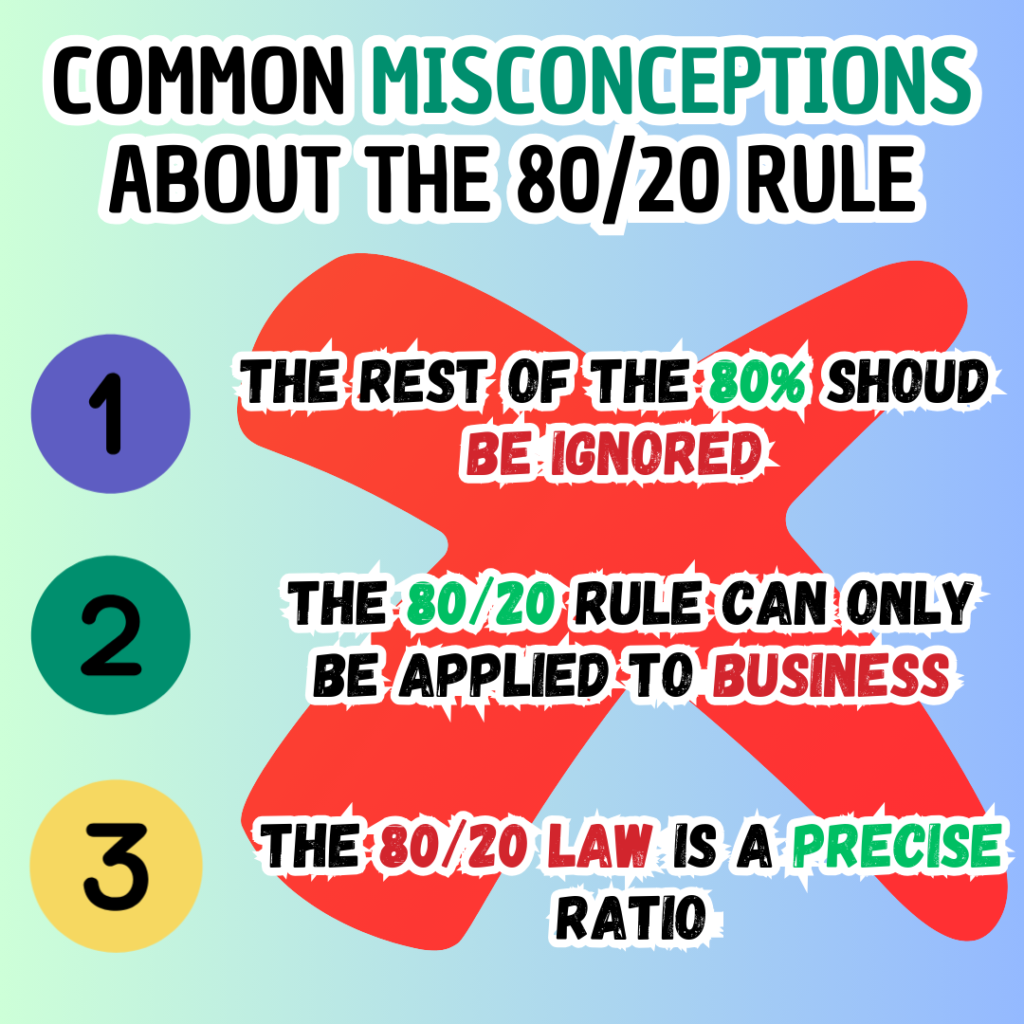
What is the 80-20 Rule or the 20 of 80 Rule?

The rule states that 80% of outputs (results) come from 20% of inputs (causes). The rule itself is used to find the actions that deliver the majority of the results and prioritize them. The 80/20 rule is used more often in business to identify the core areas the team should focus on that have the potential to deliver the most profits. However, the 80/20 rules can also be used in any given field, such as time management, productivity, decision-making, habit formation, learning and development, and even relationships.
The 80-20 rule itself means that a tiny number of causes can have a large effect. So identifying and focusing the work on this number of causes can lead to higher benefits. An example of this principle can be observed in some industries where 80% of the business’s profits are realized through only 20% of the company’s customer base.
Who invented the 80-20 rule?

The 80-20 principle was first observed by the italian economist Vilfredo Pareto in 1906. They say he observed that 80% of tea was produced only from 20% of the tea pods he got in his garden . This observation led him to discover that this can also be applied to economics. In terms of wealth distribution,he found that 20% of the population in Italy was holding 80% of wealth.
Joseph M. Juran was the first person to coin the term “Pareto effect” and the” 80-20 rule” in 1940. Now the 80-20 rule is used in a variety of disciplines in business.
Benefits of the 80-20 Rule

On an individual level, the Pareto rule can help you in many aspects, such as:
- Boosting your productivity
- Improving your time management
- Identifying what to prioritize when learning new courses
- Optimizing your study habits
The rule can be applied to many aspects. What you want to get from the rule is to know what to focus on so you can achieve high results. The 80-20 rule is meant to be a guideline, not an exact law you need to abide by.
On a business level, the 80-20 rule can help in identifying the main activities to focus on that can deliver the majority of the results. Therefore, increasing the efficiency and productivity of the business operation. It can also be applied to other main areas of business, such as identifying the portion of customers that are responsible for the majority of the profits or identifying which areas will require more resource allocation.
Examples of the pareto principle
Pareto Principle Example Investment
Sometimes 20% of the portfolio holdings from stocks can be responsible for the 80% of the loss that occurs.
In other times, it’s the opposite; 80% of the profits come only from 20% of the investment holdings.
Pareto Principle Example: Time management at work
Many people hold the idea that the more time they spend working, it will result in better outcomes. This might be true, but it can lead to neglecting work-life balance, therefore leading to burnouts and so on.
Using the 80-20 rule can help you prioritize the most important task, which can lead to the majority of the results.
Applying the pareto technique can start by giving yourself some time on your weekends to identify the most important tasks for the workdays.
You first start by listing the tasks you do at work for the week. Then analyze how much impact each task delivers to you and your company.
You can use revenue generation, client satisfaction, or project completion as some of the criteria to determine the impact of your work.
Next, prioritize the tasks into high-impact tasks and low-impact tasks.
High-impact tasks are once responsible for the majority or a large portion of the results. They are 20% of the tasks that contribute to 80% of the desired outcomes. These are the tasks that you should prioritize for more results.
The same is true for low-impact tasks; they are the ones that contribute to 20% of overall results. This type of task should be either scheduled for other times, delegated, or possibly eliminated if it is unnecessary.
You can use the SMART goal framework to schedule your important tasks.
Pareto Principle Example: Time Management at Home
Example 1:
When it comes to meal planning and cooking, it is often the case the case that there are some foods that you and your family enjoy the most. Identify the 20% of meals that you and your family enjoy the most.
Make a meal plan for the week. Buy your core ingredient in bulk. Like this, you save time from everyday grocery shopping and increase your satisfaction with the meals you consume.
Example 2:
Chores and housekeeping can consume so much time at home. Try to identify the 20% of cleaning and organizing tasks that can be enough to maintain a good overall clean environment (80% of the visible cleaness).
Focus your efforts on completing these core tasks to maintain an overall clean environment at home. Use the remaining time to do other activities you always wanted to do if you have more time.
Or you can focus on the high-traffic areas in your home, such as the kitchen or entryway. Because these places are so often visited in your home, they can get dirty easily. Focusing your efforts on cleaning and organizing this area will ensure optimized usage of your time and a better, more refreshed feeling.
Pareto Principle Example: Personal Growth and Learning
Example 1:
Habits are the core building blocks for all our daily activities. Identify the 20% of habits that, if you build them, will contribute to 80% of your personal growth.
An example of these habits is exercising. What are the types of exercise that will help you burn more calories? Identify those exercises and how many calories they burn theoretically. Then start building a habit of exercising using these exercises. You can start at 5 minutes a day and increase it to 1 hour over the course of 1 month. You can use the SMART method to write your goals.
Example 2:
The consumption of content, be it visual, audio, or written, can take so much time from your day. First, analyze the type of information you consume and identify it. Identify the 20% of information sources that are most helpful for you. Focus on consuming your content from them more.
Let’s say you watch so many short-term content videos on various platforms, such as YouTube, Instagram, and TikTok. But at the same time, you consume from time to time.
In terms of value, it is more likely that the audiobooks that you listen to from time to time deliver so much more value to you compared to the short-term video content you watch. Therefore, a good way to implement the 80/20 rule is to put the majority of the time you spend on consuming content into listening to audiobooks to get the most value possible.
4 Common Misconceptions (Myths) About the 80/20 Rule.

Misconception 1: If 20% of tasks are important, then I should only focus on them and ignore the other 80% because they are unimportant.
This is a common misconception about the pareto principle. The 80/20 rule says that 20% of inputs are causing 80% of results; therefore, you should focus more on the tasks that bring the most results. However, this does not mean to just ignore the remaining tasks. The remaining 80% of tasks or causes can be important. It is just a matter of priority. Discarding the other 80% of tasks can accumulate over time and create a big problem for you in the future.
There are two types of tasks in the remaining 80%: either a task that brings no value at all or an important task that brings value in some way. Yes, you can reduce tasks that have no value at all. But the important tasks should not be overlooked. You can either delegate the task, reschedule it for the future, or reduce the resources needed for the tasks that are still considered important.
Misconception 2: The 80/20 rule can only be applied to business.
Many businesses around the world adopt the 20/80 law in their operations because this concept helps in cutting losses and improving profits. However, this does not mean that only businesses can benefit from this rule. Normal people can apply this law to literally any field in their personal lives. Some fields where the 80/20 rule can really help are:
- Learning new materials: Often, a skill can be learned faster if you focus on the core 20% that have a huge impact on learning the skill or the material.
- Time management at home: There are certain chores that are most essential for the household. Focusing on tackling them first is a better approach and can actually free up some time.
- Productivity: Focusing on the 20% of habits that help you grow the most. 20% of habits have an 80% influence on your productivity. Watching TV, YouTube, or consuming content on social media are some activities that might take up 80% of your time. Focusing on reducing the time you spend on these activities and putting it into more high-value tasks is your way of living a life filled with value in your limited lifetime.
- Finance and investments: Sometimes 20% of the stocks you hold can generate the most profits for you. In other times, 20% of stocks actually result in most of the losses.
- Health and controlling weight: Certain foods can actually cause most of your weight gain. That’s why identifying the 20% of the food you take that causes 80% of weight gain can help you lose weight by reducing your intake of that type of food.
Misconception 3: The 80/20 law is a precise ratio.
20% of inputs can result in 80% of the outputs, which is not an exact rule in which everything should be in this 20%-80% ratio. It is a concept, not a hard science. In this concept, you want to focus on the inputs, tasks, and actions that can deliver the highest level of results and outputs. It is about the tasks that have the biggest influence on the results you want to achieve. It is a logical approach that wants you to focus your limited resources, be it time, money, or manpower, on the tasks that can be the most impactful.
Misconception 4: The 80/20 rule is about reducing work.
Knowing that 20% of causes will result in 80% of the results does not mean that you should focus only on the 20%, neglecting the remaining and reducing your work. The 80/20 rule is not about being lazy; it is about focusing the limited time you have on the most impactful actions. It is about reducing the energy you put towards tasks that have less impact on the results you want to achieve and putting the same energy towards what will have the most benefits.
How do you apply the 80-20 rule to productivity?

Let’s try to simplify the process into a few steps:
- Make a list of the actions and tasks you want to get done by the end of the day.
- Look carefully through that list of tasks. Understand how each action and task will have an impact on your day.
- Reorder the list, putting the most impactful tasks at the top of the list.
Now you have a list of the tasks that you want to do this day. The first few (maybe the first 2 or 3 tasks) are the most impactful.
- Focus your energy for the day on those 2 to 3 tasks.
- Find a solution for how to deal with the rest of the tasks.
So how do you deal with the 80% of the inputs that do not have a big impact on your day? You have 3 choices:
- Schedule for later: This is so important for deadlines. You don’t want to deal with tasks that are less important and not urgent when there is a deadline very close to you.
- Access if some of the tasks can be neglected without consequences: So some tasks are important, just not as important as the top tasks on your list. However, there are tasks that just do not have any impact on your day; even if you neglect them, they won’t matter. So for those tasks, either reduce the time you spend with them or just neglect them. An example of productivity is consuming content on social media or watching. This just does not have any impact on your day.
- Delegate the task: Let’s say the particular task is not that important compared to others but still has some significance to your result in the near or long term. What you can do is delegate the tasks to someone else. This is used so much in business. But in terms of productivity, an example is a mother who has so many tasks that need to be done. She can focus on the most impactful things for the day, such as preparing a meal. Delegate the other less impactful tasks to other family members.
In short, how to apply the 80/20 rule to productivity:
- Write down the actions or tasks you want to finish for the day.
- Identify the tasks that have the most impact on your day.
- Reorder the list, putting the most impactful actions at the top.
- Focus your energy for the day on dealing with those tasks.
- For the remaining tasks, identify if they need to be scheduled later, delegated to someone else, automated (with software if possible), or totally neglected.
The 80-20 rule comes naturally.
I am always fascinated by how a person can find himself applying different rules naturally without knowing the existence of such rules. For a long time, I applied the 80-20 rule to so many decisions on what to focus my efforts on. Even though I didn’t really know the existence of such a rule, it was just the most logical flow of thought.
I want to make the most of my day, so what should I do? Then I find myself picking the tasks that I see are the most impactful for that day and starting to apply them.
Key points are that you don’t really need to be using the precise ratio of 20% to 80% when applying this rule. It is more of a concept, so always ask yourself: What actions can I take that will have the most impact on my day? Or what actions will cause the highest results?
You want to be more productive, consider using the SMART framework.